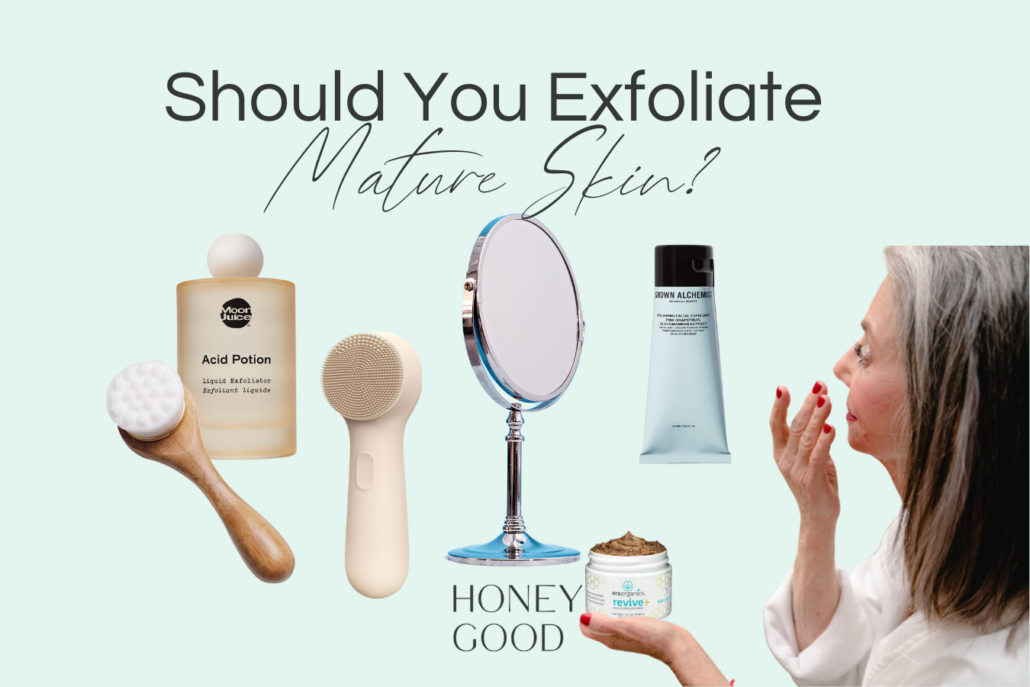Beauty expert Cora Gold wrote today’s post diving deep on the dos and don’ts of exfoliating mature skin like ours. Enjoy, darlings!

Read on to see whether or not you should exfoliate your mature skin.
*Affiliate Disclosure
To exfoliate or not to exfoliate? That is the question many people face when assessing the steps in their skincare routine.
For women with mature skin, determining whether you should try or skip it can be a whole endeavor. The interest may come from fellow skincare enthusiasts who preach exfoliation as a necessary step in their routine. After all, removing dead skin cells with the right tools can be refreshing. However, others oppose ever exfoliating.
The truth is a mix of both. Exfoliating mature skin can certainly be a fruitful addition to your skincare routine. At the same time, it’s dependent on whether it works for you and if you do it right. Everyone’s experience is different, so take a subjective view first.
Advantages of How to Exfoliate Mature Skin
Exfoliating gets plenty of praise, especially from those with oily and normal skin types. Some of its key benefits can also be seen for mature skin. By clearing out dead skin cells, exfoliation helps reveal brighter skin and a more radiant skin appearance.
1. IMPROVES RADIANCE BY REMOVING DEAD SKIN CELLS
Aging skin is undoubtedly beautiful. Smile lines and wrinkles showcase a lifetime full of joy, which can be attractive to show off. However, mature skin is also prone to dullness. Brighten up your face and body by exfoliating. Clearing out the dead skin cells makes way for new skin cells, which can appear lighter and healthier.
2. UNCLOGS PORES
Mature skin can also be much more susceptible to pollution and germs. Even with a cleanser and toner, it can’t be enough to get dirt or leftover makeup off. An excessive amount of natural dead skin cells and sebum can also be a contributing factor. Luckily, a good exfoliant works in-depth to remove all the grime clogging your pores.
3. SMOOTHS TEXTURE
Dealing with rough or bumpy textures is natural. As you get older, collagen production tends to slow down and affect your skin’s elasticity. An exfoliant can help stimulate your skin cells to produce collagen more efficiently. While it won’t return time, you can feel satisfied having softer and smoother skin.
4. EVENS OUT SKIN TONE
Some people with mature skin may experience uneven skin tone. Other people of color may already grapple with hyperpigmentation from a younger age. And while it can be a harmless and natural feature, insecurities can develop over time. Pick out an exfoliant to ensure even pigment distribution and clear your skin.
5. MAKES OTHER SKINCARE MORE EFFECTIVE
The best part about skin exfoliants is how they can make other skincare products much more effective. Clearing out dead skin cells allows your face and body to absorb serums and moisturizers more effectively. It can also help your cleansers and toners penetrate deeper for the next few days.
Chemical and Physical Exfoliants: A Comparison
When it comes to removing dead skin cells and improving skin texture, there are two main approaches: chemical and physical exfoliants. Chemical exfoliants, such as alpha hydroxy acids (AHAs) like glycolic acid and lactic acid, and beta hydroxy acids (BHAs) like salicylic acid, work by gently breaking down the bonds that hold dead skin cells together. This allows the skin to shed these dead cells more easily, revealing a smoother, brighter complexion underneath. Chemical exfoliants are especially beneficial for sensitive skin types and acne-prone skin, as they can help unclog pores and reduce inflammation without the need for harsh scrubbing.
On the other hand, physical exfoliants use small particles or tools—like scrubs, brushes, or sponges—to manually remove dead skin from the skin’s surface. While physical exfoliants can be effective for oily skin by helping to remove excess oil and dead skin cells, they can sometimes be too abrasive for sensitive or mature skin, potentially causing irritation or micro-tears.
Choosing between chemical and physical exfoliants depends on your individual skin type and concerns. For those with acne-prone or sensitive skin, a gentle chemical exfoliant containing salicylic acid or lactic acid may be the best option. If you have oily skin and prefer a more hands-on approach, a mild physical exfoliant can help remove dead skin cells and improve skin texture. No matter your choice, it’s always wise to consult with a board-certified dermatologist to find the most suitable exfoliation method for your unique skin needs.
Potential Downsides to Exfoliating
While exfoliating seems perfect, there can be potential disadvantages. Most of these downsides appear when over-exfoliating or when your skin is sensitive. Using harsh scrubs can increase the risk of irritation, especially for sensitive or mature skin.
1. DRYNESS
Certain exfoliants can be too good at stripping away dirt from your face and body, as they can also remove your face oils for a reasonable amount of time. While too much sebum can be bad for your skin, a lack of hydration can make your skin uncomfortable.
2. INFLAMMATION
Goodbye security, hello redness. Mature skin is already prone to irritation and inflammation when exposed to sunlight or pollution. However, since freshly exfoliated skin strips your face of oils, the skin has less natural protection.
3. THINNING SKIN
Mature skin can take off dead skin cells and open up a path for new ones to form. However, aging can make the epidermis grow thinner over time. If you exfoliate too much, you may risk having thin and vulnerable skin.
Are These Popular Skincare Ingredients Good for Mature Skin?
How Often Should You Exfoliate Mature Skin?
Exfoliating mature skin is all about balance and care. As we age, our skin’s natural ability to shed dead skin cells slows down, which can lead to a dull appearance and uneven skin texture. Regular exfoliation—about one to two times a week—can help remove dead skin, improve skin texture, and reveal a radiant glow. However, it’s important not to overdo it, as mature skin can be more prone to dryness and sensitivity.
For most mature skin types, using a gentle chemical exfoliant with alpha hydroxy acids or beta hydroxy acids is ideal. These ingredients help to slough away dead skin cells without causing irritation. If you prefer physical exfoliants, opt for a soft scrub or brush and use it sparingly to avoid damaging the skin. After exfoliating, always follow up with a hydrating moisturizer to soothe and protect your skin. By sticking to a regular exfoliation routine and listening to your skin’s needs, you can enjoy smoother skin texture, fewer fine lines, and a healthy, radiant glow.
Tips for Proper Exfoliation
As you start weighing the pros and cons of exfoliation, you may wonder how you can get all the goods without damaging your skin. The key is to practice a proper exfoliation routine and to thoughtfully incorporate exfoliation into your skincare routine or skin care routine for optimal results.
1. UNDERSTAND YOUR SENSITIVE SKIN
Mature skin can still have various characteristics, whether borderline dry or sensitive. Assess the state of your skin to determine whether exfoliation will be helpful to your skin or not. You can also seek a dermatologist to discuss the step’s suitability for your kind of skin.
2. PICK THE RIGHT TIMING
Timing is everything in skincare. Consider certain factors, such as when and how often you put the products on. Here’s an overview of tips:
- Exfoliate once a week: Exfoliants are abrasive, so only put them on once a week. If you feel like your skin is still supple by the same time next week, you can even skip doing it. That way, you avoid overworking the product on your face and body.
- Use exfoliants at night: Applying exfoliants can make your skin vulnerable. Give it breathing room to repair itself by reserving this part of your skincare at night. When you wake up, your skin will feel much better.
- Skip exfoliants when injured: If you have any cuts, wounds or other injuries, don’t apply any skincare to let your face and body heal. Take special care to pause exfoliation too, as it can aggravate those spots.

3. PICK THE RIGHT EXFOLIANTS, SUCH AS SALICYLIC ACID
Some people may say mature skin should only stick to a specific type of exfoliant, but it’s best to be informed about the options before deciding. Here’s an overview of the choices:
- Physical exfoliants: Physical exfoliants are used to manually remove dead skin cells and debris from your skin. Some people utilize granulated scrubs (like this one with Manuka honey), but others may opt for liquid products and apply them with brushes or shower sponges.
- Chemical exfoliants: Chemical exfoliants like glycolic and salicylic acids can exfoliate your skin inside and out. These products can be a great alternative if you’re sensitive to physically scrubbing your skin. Just be mindful of how much you use.
- Exfoliating treatments: There are professional exfoliating treatments you can seek out for your mature skin. For instance, microdermabrasion is a minimally invasive exfoliation process, primarily taking care of scarring and skin tone.
4. USE PROTECTANT
Using exfoliants over time can make your skin even more sensitive, so adopt the right habits and products. For instance, dermatologists recommend staying out of the sun if you don’t have sunscreen of 30 SPF or more. You can also look for a great moisturizer to keep your skin barrier healthy and protected.
5. FOCUS ON CERTAIN AREAS
Some assume they need to exfoliate their whole body and skin, but it isn’t essential. Look out for the problem areas you specifically want to work on. For instance, maybe your nose pores feel particularly clogged or rough. If the rest of your face feels fine, concentrate your exfoliants on that area instead.
Common Mistakes to Avoid When Exfoliating Mature Skin
While regular exfoliation can do wonders for mature skin, it’s easy to make mistakes that can lead to irritation or even damage. One of the most common pitfalls is over-exfoliating—using exfoliants too often or in high concentrations, especially with strong alpha hydroxy acids or beta hydroxy acids. This can leave mature skin feeling dry, sensitive, and more prone to redness.
Another mistake is choosing harsh physical exfoliants, such as rough scrubs or stiff brushes. These can cause micro-tears in the skin, leading to irritation and compromising the skin barrier. It’s also important to avoid exfoliating delicate areas, like the skin around the eyes, which is especially thin and sensitive.
Neglecting to moisturize after exfoliation is another common error. Mature skin needs extra hydration to maintain a radiant complexion, so always use a gentle, fragrance-free moisturizer after exfoliating. Finally, be sure to select products that are specifically formulated for mature skin and avoid those with unnecessary fragrances or harsh ingredients. By steering clear of these common mistakes and focusing on gentle, regular exfoliation, you can help your mature skin look smoother, brighter, and more youthful.
Taking a Stand on Exfoliating
The debate on exfoliation is never-ending, but you should give it a try to see whether your mature skin can take the products and benefit from them. If it works for you and you do it properly, that’s all that truly matters.
Not “smoothens” — “smooths” 🙂
I will have to talk to my editor! I am smiling!! Thank you. Warmly, Honey